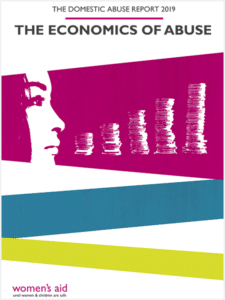The Domestic Abuse Report 2019: The Economics of Abuse

Economic abuse is often misunderstood but it is a key tactic used by perpetrators of domestic abuse to control their partner and stop her from leaving. The Domestic Abuse Report 2019: The Economics of Abuse explores the relationship between domestic abuse and economic resources, looking at the needs and experiences of survivors around finances, welfare, housing and employment (economic needs), and how these needs are met by specialist domestic abuse services.
© Women’s Aid, March 2019
Please cite this report as:
Women’s Aid (2019) The Domestic Abuse Report 2019: The Economics of Abuse. Bristol: Women’s Aid.
Key Findings
Access to money during the relationship:
- Nearly a third (31.9%) of respondents said their access to money during the relationship was controlled by the perpetrator.
- A quarter of respondents said that their partner did not let them have money for essentials during the relationship.
The cost of leaving:
- A third of respondents had to give up their home as a result of the abuse or leaving the relationship and nine found themselves homeless as a result of leaving.
- Two-fifths of all respondents who had left said they had difficulty accessing welfare benefits.
- Nearly half of respondents who had left had to pay legal fees as a result of leaving (eg divorce, child contact/custody and housing).
Ongoing impact following economic abuse:
- 56.1% of our sample who had left a relationship with an abuser felt that the abuse had impacted their ability to work and over two fifths of all respondents felt the abuse had negatively impacted their long-term employment prospects/earnings.
- 43.1% of respondents told us they were in debt as a result of the abuse and over a quarter regularly lost sleep through worrying about debt.
How services help:
- 91.8% of service providers responding to the annual survey support survivors to access food banks.
- 88.1% of responding service providers gave survivors (and their children) ‘welfare packages’ including essential toiletry items, basic clothing and food.
- 72.4% of responding service providers supported survivors to develop employability skills (including access to training, help with job applications, helping develop interview skills).
- 80.6% of services supported women to access their own income/finances which had been controlled by the perpetrator(s).